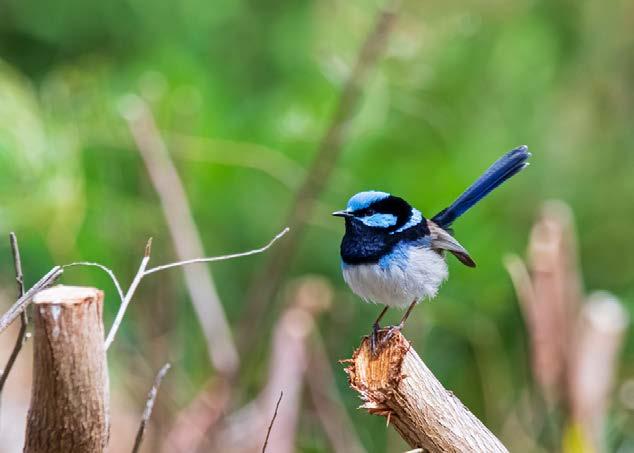
8 minute read
Nature Notes
Gio Fitzpatrick
Suburb Fairy-Wrens
Advertisement
If a tree falls in the forest and no one is around to hear it, does it make a sound?
Answer: Yes
If a bird’s song is snuffed out before you get a chance to know it, has something been lost?
Answer: Yes
Should we be doing all we can to allow its recovery?
Answer: Yes
When was the last time you shared space with a Superb Fairy-wren? Heard their rapid twittering and trilling, witnessed their unique social antics or saw the cyan on jet black of the breeding males that helped earn their description as ‘superb’? This is probably Australia’s best studied bird species and has also been voted Australia’s favourite bird, but Superb Fairy-wrens are waning as a presence in people’s daily lives. In my home city of Melbourne, they no longer nest in people’s gardens and haven’t done so for decades. This once friendly, familiar bird and “the favourite of the children” is becoming less and less recognisable for every generation. They, like so much else, are slipping into oblivion.
For those who grew up exploring the natural world in their home landscape, the community of living things, with which we share space, matters beyond ecosystem services or threatened species legislation. It’s everything. It’s the richness of life. It’s the unknowable, surprising and the strange; along with the familiar, comforting and cyclical. It’s the world outside and that within. It is the real world and perhaps humanity’s only company in the universe! Importantly, the destruction of all this is neither necessary nor inevitable. Much of it is the result of unconscious, not ill-intended, management and therein lies a great deal of hope for the power of information. The wildlife that survives alongside us in our home environments can inspire exploration, action and a sense of belonging in people.
Superb Fairy-wrens – as with all wildlife – are their own best ambassadors, but without interaction of course, a relationship can scarcely be built. If they can be brought back into people’s everyday lives through community action, a snowball-effect will hopefully ensue. Although Superb Fairy-wrens are just one piece of a whole collapsing ecosystem, they may be better placed than any other creature to guide the rescue mission for much of the rest. They have the power to spark a much-needed rethink of our gardens, parks and pavements. Indeed, they could improve our city as a whole. Let’s listen to what they have to say...
Birdwatcher and compositor for The Age newspaper, George Arthur Keartland, who thankfully took detailed notes on Melbourne’s birds in the late 19th century, once watched a pair of fairy-wrens nesting and raising chicks outside Parliament House. He described them as being ubiquitous; living in “nearly every hedge or patch of scrub around Melbourne”. What a beautiful vision… What a different world…
By the 1960’s/70’s, Superb Fairy-wrens had already declined substantially in Melbourne but were still common in some larger city parks, along the lower Yarra River and on the city’s outer fringe. Black Rock resident, birdwatcher and pioneering habitat-gardener, Barbara Salter was well acquainted with a resident pair in her garden during the 1960’s whom she knew as Button and Emily. She wrote “in the early Spring, this tiny, brilliant blue bird went skipping about the garden, carrying a bright golden flower in his beak and looking quite irresistible” and said that this pair “were so tame that they would hop over the feet of school children who came in large parties to see the birds – in fact, Button received a number of Christmas cards!”. Barbara lived adjacent to the Sandringham Golf Course which, at the time, hosted Eastern Yellow Robins, Yellow-rumped Thornbills and a great range of other birds, now absent from the area.

Fairy-wrens disappeared from Bayside’s golf courses around 1980. The last place that they survived anywhere inland in Bayside was the Bay Road Heathland Sanctuary, which despite being only about 2ha, apparently hosted 3-4 family groups into the mid-nineties. In fact, this was their last inland stronghold through the vast swath of south-east Melbourne between the Royal Botanic Gardens, Melbourne and the Mordialloc Creek (a distance of over 20km). Here too, they died. On the other side of Melbourne, they hung on into recent times in the Melbourne General Cemetery. Birdwatchers regularly reported them there into the early 2000s alongside Yellow-rumped Thornbills, which have undergone an even more complete disappearance locally and will prove far more difficult to recover.
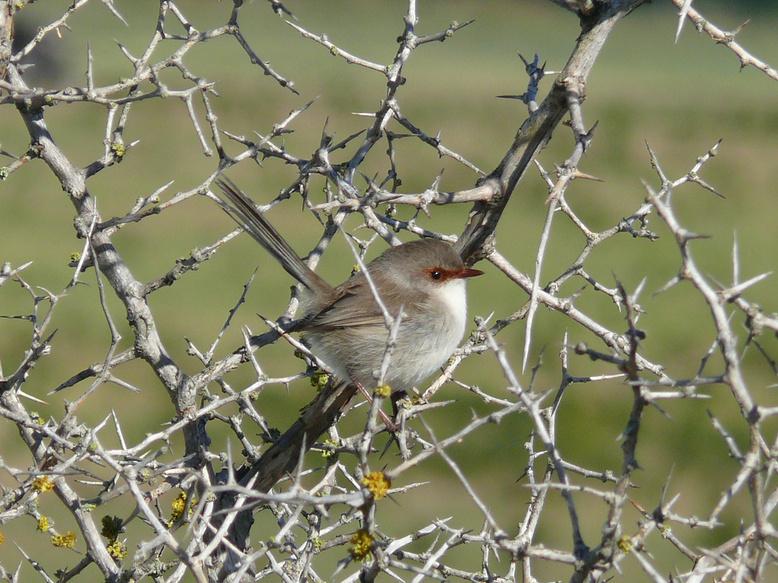
Fairy-wrens still live in the Royal Botanic Gardens today, but rather than animating the lawns and undergrowth everywhere, as they did before, they are now restricted in the areas that they use. The same is true for Royal Park, a 180ha area of green space; 90% of which is now uninhabited by Superb Fairywrens. Across the landscape of inner suburban Melbourne today, an absence of Superb Fairy-wrens is the general rule, with a light peppering of exceptions. The activity of contrasting ecological conditions in areas of absence with the select few places where fairy-wrens persist into the present day, offers insights into likely causes and solutions. The birds are already showing us what works and what doesn’t, now we must interpret the patterns and act swiftly to reverse the trajectory.
In inner suburban Melbourne, there are seventeen sites of persistence and in the north, these include:
. The grounds of the Melbourne Zoo
. Trin Warren Tam Boore/Whites Skink Habitat
. Parts of the lower Merri Creek
In the east:
. Royal Botanical Gardens
. Studley Park
. Glen Iris Park
In the south:
. The northern half of the Elwood Foreshore
. Much of Brighton’s foreshore
In the west:
. Westgate Park
. Perc White Reserve
. Stony Creek Backwash
. Lower reaches of the Moonee Ponds Creek
. Newport Lakes
. Newell’s Paddock
. Point Gellibrand
. Newport Nature Reserve
. Jawbone Flora and Fauna Reserve/Altona Coastal Park
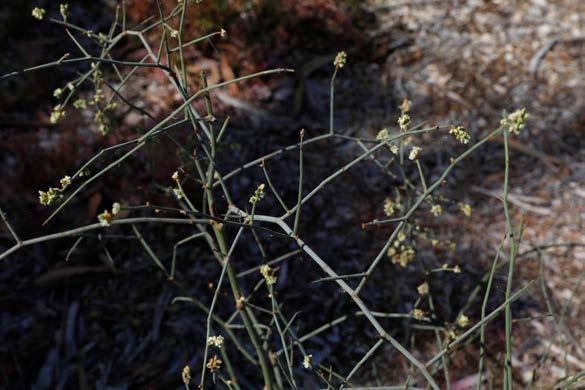
Paradise for fairy-wrens at Cherry Lake, Altona. Note the fine-scale patchwork of very low vegetation/bare ground and high-quality refuge in the form of Tangled Lignumone of the very best structural refuge plants for fairywrens
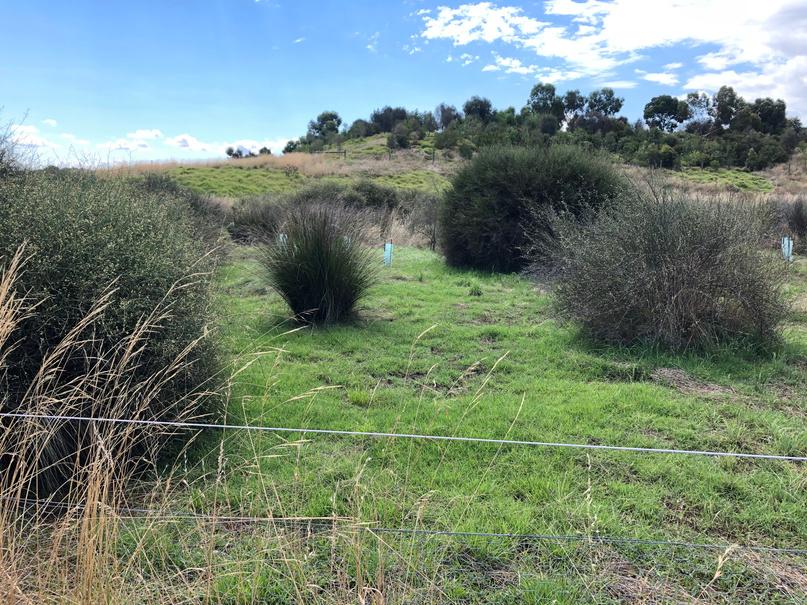
Tangled Lignum, Duma florulenta growing in the reserve. Tangled Lignum is a prominent feature at Trin Warren Tam Boore.
Though disparate in many ways, these seventeen places share some rather uncommon commonalities, aside from of course, the persistence of Superb Fairy-wrens. In general terms of value for local wildlife, these places are exceptional. Together they only make up a tiny portion of the area of inner suburban Melbourne but support an enormous proportion of the fauna diversity in the region. For example, the above sites include the top three bird migration stepping-stones in the city (Trin Warren Tam Boore/Whites Skink Habitat, Jawbone Flora and Fauna Reserve/Altona Coastal Park and the northern portion of the Elwood Foreshore) and between them, host every indigenous reptile species still existing in the region (13 species in total).
One could say – its no surprise that the last fairy-wrens remain in the highest-quality sites and that these are also the last strongholds for other declining wildlife, but that would miss an important detail. There is no such thing as high-quality habitat in general. Assessments of habitat quality are really only meaningful when made in relation to a given species or guild (or even a certain life-stage of a given species or within a certain ecological context). Pristine, old-growth, wet forest is terrible habitat for a Coast Saltbush or a Stubble Quail and high-quality temperate grassland would be a death-trap for a Greater Glider or a Rough Tree Fern.
So why then, does good habitat for fairy-wrens seem to constitute good habitat for such a diverse range of wildlife which actually specialise in living in very different habitats to one another?
The fairy-wren’s requirements cut through questions of habitat-type or ecological vegetation class to instead focus on certain key and universal characteristics which we often lose sight of, even in dedicated restoration attempts. They hop around the cool watery world of Southern Water Skinks and Delicate Skinks under a canopy of giant River Red Gums but are equally happy fossicking through the hot, dry sands of the Brighton dunes with Bougainville’s Skinks and White’s Skinks. The thirteen indigenous reptiles left in inner Melbourne are each, to varying degrees, restricted to certain parts of an environmental spectrum. Superb Fairy-wrens on the other hand, can happily jump across almost the whole spectrum from freshwater wetlands to rocky cliffs, escarpments, forests, grasslands, woodlands, scrubs, heaths, salt marshes and once upon a time, the manicured gardens of parliament house.
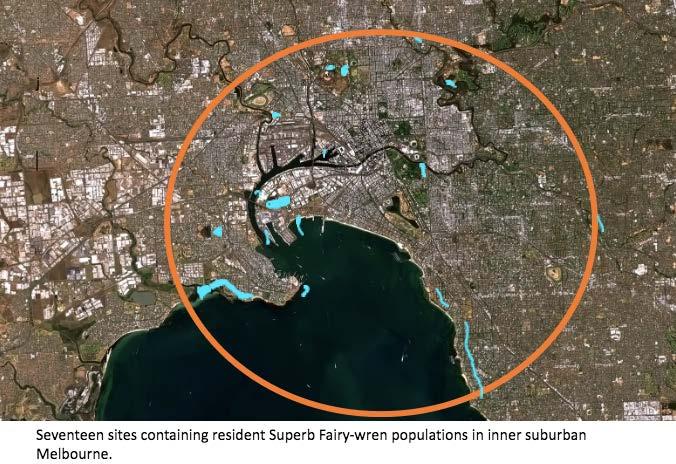
They could seem like the ultimate generalist but why then do we see them surviving in so few places and why do those places have such a high likelihood of hosting healthy populations of otherwise struggling wildlife? The fairy-wrens, don’t care that much about such fundamentals as floristics, overall vegetation type or even mesoclimate but, in a nutshell, appear need two things above all else; heterogeneity in the vegetation structure and productivity of insects. No wonder they are such a great indicator of habitatvalue across so many disparate habitats… Insects, of course, underpin virtually all terrestrial food webs as the greatest converters of plant material in animal tissue and heterogeneity in the vegetation structure largely drives species diversity.
When low and middle-story vegetation occurs without trees directly overhead or nearby, fairy-wrens are more willing to forage in the open; probably because there are fewer perches for aggressors such as Noisy Miners and predators such as Grey Butcherbirds and Collared Sparrowhawks. 'Understory' shouldn't be assumed to always imply that something is above.
The presence of water more or less enforces heterogeneity in the vegetation structure. Whether it be the transition from stunted trees, through shrubs and grasses to bare sand on a beach or the complexity of a riparian zone on a river; somewhere, sunlight will reach the ground-layer in abundance while dense vegetation provides cover nearby. This is the structurally complex mosaic that fairy-wrens and so many other organisms thrive in, but that our urban green spaces (including remnants and revegetation) so seldom offer.
Waterbodies themselves also tend to boost and diversify the food on offer for things like fairy-wrens. At Hampton they’ve been seen picking through freshly beach-cast seaweed - probably for amphipods and other crustaceans. The edges of wetlands are among the most productive environments in which to find invertebrates. For a bird which predominantly gleans its prey from surfaces, the clouds of Chironomid midges emanating from the water are probably not directly of much interest, but the dense populations of Long-jawed and Orb-weaving spiders which they support certainly would be.
Two introduced fishes which have devastated aquatic environments in our region – Mosquitofish and European Carp – should also be of interest to the fairy-wren restorationist. Although there are many examples of coexistence between one or both of these fishes and the bird, it stands to reason that there’d be a great deal more food on offer for a ground and foliage-gleaner if carp weren’t depriving aquatic ecosystems of light and plagues of Mosquitofish weren’t consuming most of the insect larvae before they can take flight.
So, even aquatic environments could be beneficiaries of the Superb Fairy-wren’s ambassadorial umbrella i.e. if wetlands were managed to control these fishes for the benefit of fairy-wrens, everything in the water from tadpoles to turtles and the entire submerged plant community will benefit.
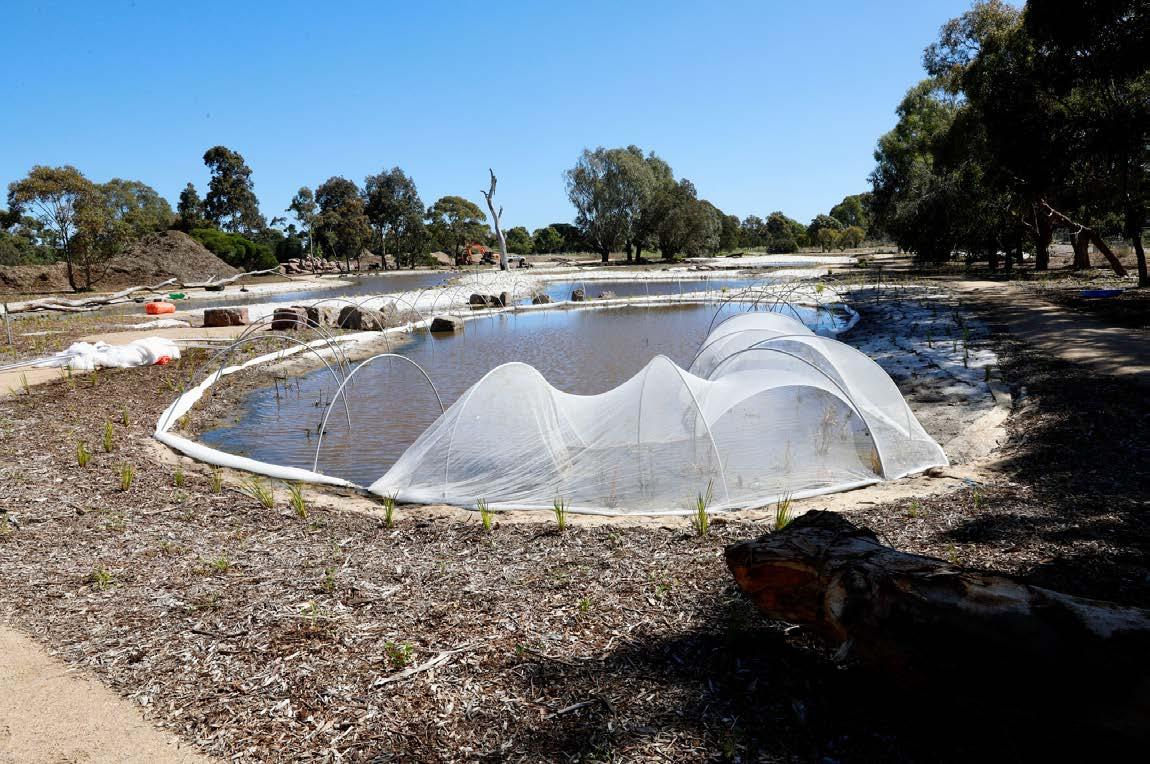
The temptation to homogenise revegetation sites with trees all too often starves the ground-layer of light. There are several examples around the city of Superb Fairy-wrens thriving under powerlines which precluded the planting of trees, as seen here.







